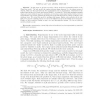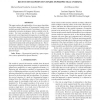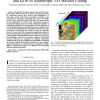151
Voted
CORR
2012
Springer
13 years 8 months ago
2012
Springer
We consider the problem of recovering a target matrix that is a superposition of low-rank and sparse components, from a small set of linear measurements. This problem arises in co...
115
Voted
SIAMIS
2011
14 years 3 months ago
2011
In this paper we propose an active contour model for segmentation based on the Chan-Vese model. The new model can capture inherent sharp features, i.e., the sharp corners of object...
122
click to vote
IGARSS
2010
14 years 10 months ago
2010
This paper explores the applicability of new sparse algorithms to perform spectral unmixing of hyperspectral images using available spectral libraries instead of resorting to well...
104
click to vote
ICIP
2010
IEEE
14 years 10 months ago
2010
IEEE
We propose a new method to unmix hyperspectral images. Our method exploits the structure of the material abundance maps by assuming that in some regions of the spatial dimension, ...
88
Voted
ICIP
2010
IEEE
14 years 10 months ago
2010
IEEE
This paper is concerned with joint Bayesian endmember extraction and linear unmixing of hyperspectral images using a spatial prior on the abundance vectors. We hypothesize that hy...
148
Voted
TIP
2008
15 years 20 days ago
2008
Abstract--Hyperspectral images present some specific characteristics that should be used by an efficient compression system. In compression, wavelets have shown a good adaptability...
111
Voted
KES
2008
Springer
15 years 22 days ago
2008
Springer
Abstract. Classification of hyperspectral images is paramount to an increasing number of user applications. With the advent of more powerful technology, sensed images demand for la...
120
Voted
ESANN
2006
15 years 2 months ago
2006
Spectral classification, segmentation and data reduction are the three main problems in hyperspectral image analysis. In this paper we propose a Bayesian estimation approach which ...
107
Voted
HAIS
2010
Springer
15 years 5 months ago
2010
Springer
Abstract. In remote sensing hyperspectral image processing, identifying the constituent spectra (endmembers) of the materials in the image is a key procedure for further analysis. ...
116
click to vote
SBCCI
2003
ACM
15 years 6 months ago
2003
ACM
Unsupervised clustering is a powerful technique for understanding multispectral and hyperspectral images, being k-means one of the most used iterative approaches. It is a simple th...



